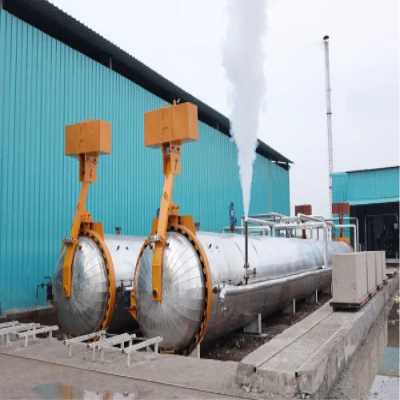Get In Touch
Get In Touch




AAC (Autoclaved Aerated Concrete) Block Machinery refers to the equipment and machines used in the production of AAC blocks, a lightweight and eco-friendly building material. These machines typically include a variety of components such as mixers, molds, curing chambers, cutting equipment, and more. The process involves mixing sand, cement, lime, and aluminum powder to create a slurry, pouring it into molds, and autoclaving it to cure and harden the blocks. AAC blocks are known for their excellent insulation properties, low weight, and sustainable characteristics, making AAC block machinery essential in modern construction for creating energy-efficient and durable structures.
1. AAC Mixer: - Capacity: Typically measured in liters or cubic meters. - Mixing Time: Specify the time required for thorough mixing of raw materials (sand, cement, lime, aluminum powder, and water). - Motor Power: Indicate the power of the mixer's motor.
2. AAC Molds: - Dimensions: Specify the size and shape of the molds to produce AAC blocks of desired dimensions. - Material: Identify the material used for molds, often steel or aluminum. - Number of Cavities: Mention the number of block cavities each mold can create.
3. Autoclave: - Autoclave Size: Specify the dimensions of the autoclave chamber. - Autoclave Pressure: Indicate the pressure at which the blocks are cured, usually measured in bars. - Curing Temperature: Specify the temperature used for curing the AAC blocks. - Curing Time: Mention the duration of the curing cycle. - Heating System: Describe the heating method, which can be steam, electricity, or gas. - Safety Features: Include safety systems like pressure relief valves, temperature controllers, and emergency shutdown mechanisms.
4. Cutting Equipment: - Cutting Type: Specify whether it's a vertical or horizontal cutting machine. - Cutting Capacity: Indicate the maximum block size that can be cut. - Cutting Accuracy: Mention the precision of cutting to ensure consistent block dimensions. - Motor Power: Specify the power of the cutting equipment's motor.
5. AAC Block Handling and Packaging: - Handling System: Describe how the finished AAC blocks are handled, often involving conveyors, palletizers, and stacking systems. - Packaging: If applicable, include details on block packaging, such as wrapping or strapping.
6. Control System: - Automation Level: Specify the degree of automation, from manual to fully automated systems. - Control Panel: Describe the control panel and human-machine interface (HMI) for operating and monitoring the machinery. - PLC (Programmable Logic Controller): Mention the brand and model of PLC used for automation.
7. Power Requirements: - Electrical Supply: Specify the required voltage, phase, and frequency. - Compressed Air: Indicate the air pressure and consumption for pneumatic components, if applicable.
8. Maintenance and Support: - Maintenance Requirements: Detail routine maintenance tasks and schedules for the machinery. - Spare Parts: Specify the availability and source of spare parts. - Technical Support: Describe the technical support and training provided by the manufacturer.
9. Compliance: - Ensure that the machinery complies with relevant industry standards and safety regulations.
1. Construction Industry: AAC block machinery is primarily used for manufacturing AAC blocks, which are popular in various construction applications, including residential, commercial, and industrial buildings.
2. Residential Buildings: AAC blocks produced by this machinery are used for residential structures such as houses and apartment buildings. They offer excellent insulation properties, reducing energy consumption and providing comfortable living spaces.
3. Commercial Buildings: AAC blocks are employed in the construction of commercial structures like offices, shopping centers, hotels, and warehouses due to their lightweight nature and thermal insulation capabilities.
4. Industrial Buildings: The machinery produces AAC blocks used in the construction of industrial facilities, factories, and manufacturing plants. AAC blocks are resistant to fire and chemicals, making them suitable for industrial environments.
5. Educational Institutions: AAC blocks are used in the construction of schools, colleges, and universities, providing energy-efficient and durable building solutions.
6. Healthcare Facilities: Hospitals and healthcare centers benefit from AAC blocks' insulation properties, creating controlled environments for patients and medical equipment.
7. Hotels and Hospitality: AAC blocks are used in hotels and resorts, offering energy savings and comfortable spaces for guests.
8. Retail Outlets: Retail stores and shopping centers are constructed using AAC blocks, benefiting from their cost-efficiency and insulation.
9. Warehouses: Warehouses and storage facilities utilize AAC blocks for their insulating properties and cost-effective construction.
10. Infrastructure Projects: AAC block machinery plays a role in infrastructure projects like bridges, tunnels, and drainage systems, where the lightweight blocks help reduce structural loads.
11. Renovation and Retrofitting: AAC blocks can be used in renovation and retrofit projects to improve the energy efficiency of existing structures.
12. Affordable Housing: AAC blocks, produced with efficient machinery, contribute to the construction of affordable and sustainable housing in various regions.
13. Green Buildings: AAC blocks align with green building and sustainability initiatives due to their energy efficiency and reduced environmental impact.
14. Soundproofing: In applications where soundproofing is essential, such as recording studios and home theaters, AAC blocks are used to create acoustically insulated spaces.
15. Partition Walls: AAC blocks are employed in interior partition walls to divide large spaces efficiently.
16. Exterior Cladding: AAC blocks can be used for exterior cladding in combination with other construction materials to enhance a building's aesthetics and insulation.
17. Residential and Commercial Complexes: Multi-use complexes often utilize AAC blocks for the construction of various building components.


